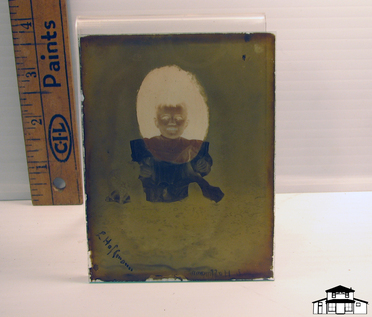This artifact is a glass plate with a photographic image on it.<\/p>\r\n
<\/p>\r\n
This glass plate belonged to Ladislaus Hoffmann. He used his camera and equipment mostly in Saskatchewan and Aldergrove before the family moved to Pitt Meadows. The child is unknown, but perhaps it is one of his own children, although we cannot be certain. The circle around the child’s face is where someone attempted to remove more of the emulsion to get a clearer image.<\/p>\r\n
<\/p>\r\n
Glass plates were originally used for photographic negatives (until the invention of cellulose nitrate film) and were popular from the 1850s through the 1920s. There are two different types of glass plate negatives: collodion wet plate negatives (1855 to 1880s) and gelatin dry plate negatives (1880s to 1920s). Ladislaus more than likely used dry plate negatives when creating his glass plate negatives. The silver gelatin dry plates were coated with a gelatin emulsion of silver bromide. These plates could be stored until the photographer was ready to use them to take a photo. These were able to be mass-produced and amateur and professional photographers liked using them, it also helped create a standard and predictable image compared to the old wet glass negatives. Unfortunately, due to their nature, glass is breakable and extremely fragile. Glass plates can be cracked and broken, and the image can be lost forever. The chemicals on the plate can also deteriorate as the emulsion degrades. The environment the plates are stored can also damage the glass.<\/p>","SEO_LINK":"glass-plate-photograph","VIDEO_LINK":"","SOUNDCLOUD_LINK":"","IMG1":"1718923374_main_glass-plate-photograph_1.jpg","IMG2":"","IMG3":"","IMG4":"","IMG5":"","IMG6":"","IMG7":"","IMG1_THUMB":"1718923374_thumb_glass-plate-photograph_1.jpg","IMG2_THUMB":"","IMG3_THUMB":"","IMG4_THUMB":"","IMG5_THUMB":"","IMG6_THUMB":"","IMG7_THUMB":""}X
Glass Plate Photograph
This artifact is a glass plate with a photographic image on it.
This glass plate belonged to Ladislaus Hoffmann. He used his camera and equipment mostly in Saskatchewan and Aldergrove before the family moved to Pitt Meadows. The child is unknown, but perhaps it is one of his own children, although we cannot be certain. The circle around the child’s face is where someone attempted to remove more of the emulsion to get a clearer image.
Glass plates were originally used for photographic negatives (until the invention of cellulose nitrate film) and were popular from the 1850s through the 1920s. There are two different types of glass plate negatives: collodion wet plate negatives (1855 to 1880s) and gelatin dry plate negatives (1880s to 1920s). Ladislaus more than likely used dry plate negatives when creating his glass plate negatives. The silver gelatin dry plates were coated with a gelatin emulsion of silver bromide. These plates could be stored until the photographer was ready to use them to take a photo. These were able to be mass-produced and amateur and professional photographers liked using them, it also helped create a standard and predictable image compared to the old wet glass negatives. Unfortunately, due to their nature, glass is breakable and extremely fragile. Glass plates can be cracked and broken, and the image can be lost forever. The chemicals on the plate can also deteriorate as the emulsion degrades. The environment the plates are stored can also damage the glass.
Details:
Latitude: 49.2254836054341
Longitude: -122.69000437249
Direct Link: https://www.pittmeadowsmuseum.com/locations/glass-plate-photograph


